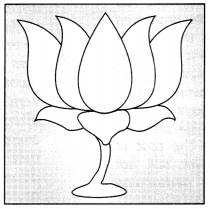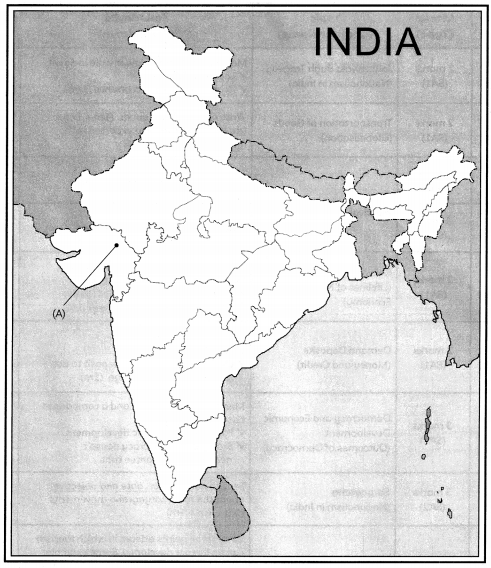Students can access the CBSE Sample Papers for Class 10 Social Science with Solutions and marking scheme Term 2 Set 6 will help students in understanding the difficulty level of the exam.
CBSE Sample Papers for Class 10 Social Science Term 2 Set 6 for Practice
Time Allowed: 2 Hours
Maximum Marks: 40
General Instructions:
- This Question paper is divided into five sections-Section A, B, C, D and E.
- All questions are compulsory.
- Section-A: Question no. 1 to 5 are very short answer type questions of 2 marks each. Answer to each question should not exceed 40 words.
- Section-B: Question no. 6 to 8 are short answer type questions, carrying 3 marks each. Answer to each question should not exceed 80 words.
- Section-C: Question no. 9 and 10 are long answer type questions, carrying 5 marks each. Answer to each question should not exceed 120 words.
- Section-D: Question no. 11 and 12 are Case Based questions.
- Section-E: Question no. 13 is map based, carrying 3 marks with two parts, 13.1 from History (1 mark) and 13.2 from Geography (2 marks).
- There is no overall choice in the question paper. However, an internal choice has been provided in a few questions. Only one of the choices in such questions have to be attempted.
- In addition to this, separate instructions are given with each section and question, wherever necessary.
SECTION – A [2 × 5 = 10]
(Very Short Answer Type Questions)
Question 1.
Where and why did the famous Jallianwala bagh incident occur? (2)
Question 2.
Which goods were exported by colonies like India during the nineteenth and twentieth century? (2)
Question 3.
Observe the political symbol and answer the following questions.

(A) Identify the political party that uses this symbol to contest elections. (1)
(B) Who allots symbols to political parties? (1)
Question 4.
Railways in India bind the economic life of the country. Validate the statement. (2)
Question 5.
Do demand deposits constitute money in modern times? (2)
Section-B [3 × 3 = 9]
(Short Answer Type Questions)
Question 6.
Do you think democracy and economic development are interrelated? Validate your stand. (3)
Question 7.
Satyagraha was introduced by Gandhi after he came from South Africa as a novel method of mass agitation. Mention and explain three Satyagraha movements organised by Gandhi. (3)
Question 8.
There is a vast potential for development of tourism in all parts of the country. Validate the given statement.
OR
Most Jute mills are located in Bengal. Do you agree? Support your stand by giving three points. (3)
Section – C
(Long Answer Type Questions)
Question 9.
How did the rich peasant communities feel about the Civil Disobedience movement?
OR
The first challenge is the lack of internal democracy within parties. Elaborate upon the given statement. (5)
Question 10.
What are the sources of Informal Loans? Should there be a regulator for informal credit lenders? Will that solve the problem of debt traps? Elaborate your stand.
OR
The growing importance of road transport vis-a-vis rail transport is rooted in multiple factors or reasons. Enlist these reasons. (5 )
Section-D [4 × 2 = 8]
(Case Based Questions)
Question 11.
Read the source given below and answer the questions that follow:
In recent years, the central and state governments in India are taking special steps to attract foreign companies to invest in India. Industrial zones, called Special Economic Zones (SEZs), are being set up. SEZs are to have world class facilities: electricity, water, roads, transport, storage, recreational and educational facilities. Companies who set up production units in the SEZs do not have to pay taxes for an initial period of five years. Government has also allowed flexibility in the labour laws to attract foreign investment. You have seen that the companies in the organised sector have to obey certain rules that aim to protect the workers’ rights. In recent years, the government has allowed companies to ignore many of these. Instead of hiring workers on a regular basis, companies hire workers “flexibly’ for short periods when there is intense pressure at work. This is done to reduce the cost of labour for the company. However, still not satisfied, foreign companies are demanding more flexibility in labour laws.
(A) Companies in the organised sector have to obey certain rules that aim to protect the workers’ rights. Name two such rules. (2)
(B) Do you think the kind of industrial development based on loose labour laws is sustainable? (1)
(C) Give one word to replace the bold phrase. (1)
Question 12.
Read the given source and answer the questions that follow:
As the movement spread, foreign cloth was boycotted, and liquor shops were picketed. Peasants refused to pay revenue and chaukidari taxes, village officials resigned, and in many places forest people violated forest laws – going into Reserved Forests to collect wood and graze cattle. Worried by the developments, the colonial government began arresting the Congress leaders one by one. This led to violent clashes in many places. When Abdul Ghaffar Khan, a devout disciple of Mahatma Gandhi, was arrested in April 1930, angry crowds demonstrated in the streets of Peshawar, facing armoured cars and police firing. Many were killed. A month later, when Mahatma Gandhi himself was arrested, industrial workers in Sholapur attacked police posts, municipal buildings, law courts and railway stations – ail structures that symbolised British rule. A frightened government responded with a policy of brutal repression. Peaceful satyagrahis were attacked, women and children were beaten, and about 100,000 people were arrested.
(A) Mention a few programmes which were undertaken in the Civil Disobedience movement. (1)
(B) Why was the civil disobedience movement relaunched? (2)
(C) How did people react to the arrest of Mahatma Gandhi? (1)
Section-E [1 × 3 = 3]
(Map Skill Based Questions)
Question 13.
(A) On the given outline Political Map of India, identify the place marked as A with the help of following information and write its correct name on the line marked near it.
(a) Identify a place in Gujarat where satyagraha movement for cotton mill workers was held. (1)
(B) On the same given map of India, locate the following:
(a) Haldia Port
OR
Mumbai Software Technology Park (1)
(b) Bokaro Iron and Steel Plant (1)
